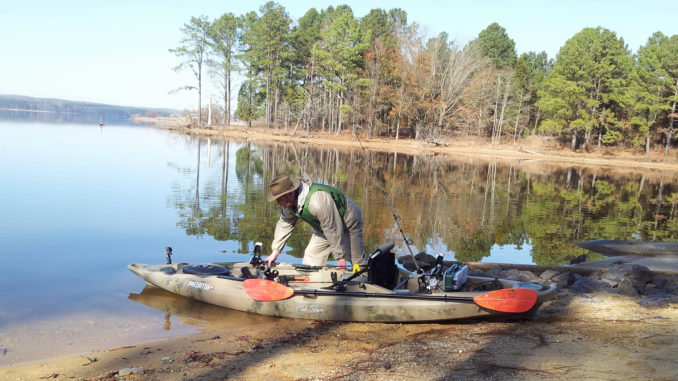
Fishing kayaks are growing market for anglers
Over the past few years, paddle sports have invaded the outdoors world, with no signs of slowing. In particular, fishing from kayaks has grown exponentially as people realize convenience, cost and accessibility can be found in an otherwise expensive hobby. No longer needed are motors with a hefty price tag that require maintenance, nor licensing fees for both vessel and trailer — not even a truck that can costs as much as a starter home to hit the waters and find big fish.
However, all kayaks are not created equal. Because of its geographic variety, North Carolina offers all types of waters, so you need to know what type and design works best with the type of water you plan on fishing.
Here are a few tips in what to look for when entering the kayak market:
Basic design
Two basic types of kayaks exist: sit-on-top and the sit-inside. The sit-on-top can be used for multiple activities and has become a favorite design for angling. Unlike the traditional sit-inside kayak, the sit-on-top allows paddlers to sit on top of a deck that is above the water line. Many are stable enough to stand on as well, allowing for sight-fishing. Because of the increased possibility of water splashing on top of the deck, scupper holes embedded throughout that allow the water to self-bail. Plugs are used in the scupper holes to prevent water from coming from under the deck, and one-way plugs allow water to run out but not come in. Decks may provide many orientations, with hatches for storage within the hull, attachments for rod holders, paddle holders, and electronics, and even open areas for standing or crate and cooler storage.
Rivers/Streams
Rivers and streams in North Carolina include both running whitewater and dormant stillwater areas. Drew Haerer, who is a pro-staffer for Malibu Kayaks, ideally likes a kayak that is both fast for the slower sections of rivers, yet maneuverable through the rougher waters in order to avoid obstacles.
“Another feature I want is a large bow that can take on the waves formed by rapids and also plenty of hull storage, so that I can carry gear for weekend long paddling-fishing-camping adventures,” he said.
Hulls are usually crescent or banana, aka rocker, shaped to allow for quick turns with little drag through the water. They also have few tunnels or channels that run along the hull.
Lakes/Ponds
Small lakes and ponds offer open, flat water in a more confined area. Ideally, a kayak for this type of water is both stabile and can track well in straight lines. While the hull is similar to the river-style kayak as far as the shape, the rocker is less curved, and the bow and stern tend to be more aggressive. This helps keep the kayak from turning with small winds or wakes. The kayak will often be between 12 to 14 feet long and wider.
Daniel Seaman of Rocky Mount prefers a wide, open platform and pontoon style hull to maximize stability.
“I predominately use a fly rod, so I want absolutely nothing to get in the way of my fly line if I happen to hook a running fish. The pontoon-style hull allows you to stand comfortably because your feet are below the water line, instead of on top like a typical sit-on-top kayak.”
Large water/Coastal
On larger bodies of water such as the ocean, sounds or large lakes, a long, narrow kayak is a must — typically between 13 and 15 feet long and around 30 inches wide — to ease the effort of paddling long distances, keep the kayak tracking straight and cut through the water quickly. The rocker is flatter than the other two styles, which reduces maneuverability. Paddling and winds can turn a kayak, while this style is less affected.
Professional kayak angler Drew Gregory of Charlotte explains. “What you want to look for is a boat that comes in really hard and sharp at the knuckles and contains less rocker in order to keep more boat in the water to prevent spinning,” he said.
Dean Radford of Morganton regularly fishes rivers as well as coastal areas. One aspect he notes is, “Having a larger more stable boat during anchoring around shoals is a big plus.”
There are many types of water and many styles of kayaks designed to navigate these waters. They offer a way to get to waters in which boats simply cannot, and are less expensive. Most of all however, it is just more fun.



Be the first to comment